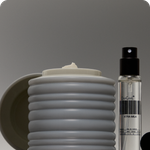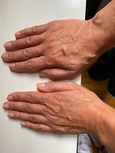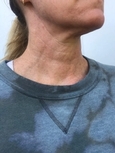Mature Skin
muh · choor –skinMature skin is skin that shows the signs of aging—such as fine lines, wrinkles, dryness, sagging, and uneven tone—caused by a gradual loss of collagen, elastin, and moisture over time.
Also Called
Aging skin
Frequently Found On
Neck, chest, hands, arms, and other sun-exposed areas.
What’s Maturing Body Skin?
Our skin naturally undergoes intrinsic aging—an inevitable process driven by internal changes that affect the very foundation of our skin structure. As we get older and wiser, our bodies slow down. This includes collagen and elastin production, two important skin building blocks that function side by side. The former is a protein that most of our skin is made of and provides structural integrity and firmness. The latter provides elasticity and a quick recoil. This natural passage of time, menopause, and genetic factors contribute to the aging process. Skin can be smooth and unblemished, but show loss of volume and a saggy appearance1.
Skin aging can also be influenced by external and lifestyle factors, including sun exposure, smoking,alcohol consumption, harsh weather conditions, diet, and more. With this type of aging, especially due to sun damage, skin can become leathery, red, spotty, and crepey with wrinkles that start small but gradually deepen as collagen breaks down1.
This combination of internal and external factors results in the common signs of visible aging seen with maturing skin: fine lines, wrinkles, loss of volume, a saggy appearance, uneven skin tone, hyperpigmentation, and increased dryness.
How Body Skin Aging is Different from Facial Skin Aging
Body skin generally has a thicker dermis than facial skin, making it more resilient to certain aging effects. However, this same thickness means skin cell turnover happens more slowly, resulting in drier, rougher texture over time2.
Another important difference is moisture retention. Body skin contains fewer sebaceous glands and natural moisturizing factors than facial skin, making it more prone to dryness and dehydration as we age. This becomes especially noticeable in areas like the chest and arms.
For women, hormonal changes dramatically accelerate skin dryness across all body areas. The significant drop in estrogen during menopause not only affects facial skin but can cause widespread dryness from hands to décolletage, and may extend to vaginal dryness as well.
The way aging visibly manifests also differs. While facial skin develops wrinkles largely from repeated expressions, body skin tends to show aging through textural changes and loss of firmness. Additionally, sun exposure patterns vary—facial skin typically receives daily UV exposure, while body skin often experiences intermittent but intense sun exposure. This is why exposed areas like the hands and chest can show accelerated signs of photoaging while covered areas age more slowly.
Understanding these fundamental differences explains why using the same anti-aging approach everywhere might not be the most efficient approach. What works for your face might not work as well for your body, particularly for vulnerable areas like the hands, neck, and chest, which have unique structural characteristics and environmental exposure patterns.
Where Does Aging Show Most on the Body
Our skin shows visible signs of aging at different rates across the body, with certain areas revealing changes much earlier than others due to their unique structures and exposure patterns.
Hands
Hands often reveal aging first, showing changes as early as our 20s. Their thin skin—comparable to eyelids—endures constant environmental exposure, washing, and daily activities (let's be honest, mostly labor).
Volume loss makes veins and tendons more visible, while UV exposure creates brown spots at the epidermis (the top-most layer of skin) base. Without oil glands, hands are especially prone to dryness, which exacerbates fine lines and rough texture. Constant washing strips natural oils further, and hands rarely receive the protection or care we give our faces despite enduring more wear and tear.
For women, menopause dramatically accelerates these changes, resulting in translucent-looking skin and crepey texture that's more prone to tearing. Even nails reflect aging, with decreasing keratin (the primary protein our nails are made of) production causing brittleness in up to 20% of people, particularly women over 50.
Neck
Neck skin presents its own challenges—thinner than facial skin yet constantly bent with every downward glance. "Tech neck" lines develop from repeated creasing patterns, while sleep positions can reinforce these patterns for hours each night. The neck's fewer oil-producing glands compared to the face lead to dryness that compounds these issues.
The resulting sagging skin (often called "turkey neck"), horizontal lines, and loss of jawline definition become increasingly pronounced and resistant to improvement as collagen and elastin production diminishes with age.
Chest
The chest area ages distinctly due to its thin skin and fewer oil-producing glands. The décolletage experiences intermittent but intense UV exposure (think low cut necklines and all your joyous days spent outdoors), leading to vertical lines between the breasts ("cleavage rhytides"), pigmentations, and textural changes. Side sleeping can create compression wrinkles that can become permanent over time.
How to Treat Maturing Body Skin
Research shows that retinoids, a family of vitamin A derivatives such as retinol, retinal, and retinoic acid (or tretinoin), remain the gold standard for treating aging skin, including on the body. Retinoids works comprehensively by stimulating collagen production, accelerating skin cell turnover, reducing hyperpigmentation, and strengthening overall skin structure1. Studies show that topical application of 1% retinol significantly reduces matrix metalloproteinases while increasing fibroblast growth and collagen synthesis in aged skin1.
Prescription-strength retinoids, also known as tretinoin, retinoinic acid, or RetinA, can be harsh for sensitive skin and are not the most accessible. Retinol is a great alternative as it is widely available over the counter. Retinol is a gentler form of retinol, as it goes through two conversions by our skin once applied, before our bodies turn it into vitamin A. Because of this, results often take longer to show; however, it causes less irritation while still effectively producing beneficial changes over time, making it ideal for body skin, which often requires gentler treatment1.
For optimal results, retinol should be applied at night to areas like hands, neck, and chest. Despite it being a gentler form, a gradual introduction is recommended to acquaint your skin with this potent ingredient. Always combine with daytime sun protection and ingredients focused on hydration and sealing in moisture to maintain the skin's barrier function.
While these fundamental principles apply broadly across the body, effective anti-aging treatment requires recognizing that different body areas age in distinct ways and therefore may benefit from customized approaches.
Hands
Daily protection forms the cornerstone of hand care: apply sunscreen consistently, wear UPF gloves when driving, and protective gloves during outdoor activities like gardening and household tasks, and moisturize immediately after washing. For targeted treatment, use retinol formulations at night when hands are at rest, which allows for maximum absorption without interruption.
Neck and Chest
These delicate areas demand gentler treatment: extend your facial skincare routines downward, with consistent sun protection and moisturizing. When using retinoids, start with a lower-strength formulation applied just 1-2 times weekly, gradually increasing frequency as tolerance develops. Specialized neck creams are not necessary, but seek out a moisturizer with peptides and ceramides for additional support. Consider wearing silicone or hydrocolloid patches at night to prevent sleep-induced wrinkles. Same as with hands, diligent sun protection will be the best form of prevention for further damage.
Advanced Treatment Options
Professional treatments can significantly enhance results when added to a daily care routine. Non-invasive procedures such as microdermabrasion and customized chemical peels provide notable improvement in skin texture and tone. For those seeking more dramatic results, minimally invasive treatments like microneedling, laser therapy, and injectable fillers can address deeper signs of aging.
Mass Index Recommends

Soft Services
Theraplush
$62
1.7 fl oz
fragrance-free
Cushion-coat hands in a soft, waxy layer of nourishing, soothing and repairing ingredients overnight, for a just-manicured feeling each morning.

Soft Services
Software Update
$44
2.5 fl oz
fragrance-free
A lightweight, creamy overnight serum designed to promote surface skin cell renewal with 0.25% retinol. Ideal for addressing both preventative and existing signs of aging.
How to Minimize Maturing Body Skin
While we cannot fully stop aging, we can significantly slow its visible progression through strategic lifestyle choices. These approaches complement topical treatments.
As mentioned above, daily protection is the foundation of anti-aging care. Broad-spectrum sunscreen should be applied to all exposed areas, not just the face. Consider UPF protective clothing during outdoor activities, and protect hands from environmental damage by wearing gloves during tasks like gardening or cleaning. After washing, immediately apply moisturizer to rehydrate skin and impart moisture.
Lifestyle choices significantly impact how our skin ages. Smoking and alcohol consumption can dramatically accelerate the aging process throughout the body. Smoking constricts blood vessels, depleting skin of oxygen and essential nutrients while impairing its ability to repair itself. It promotes the production of metalloproteinases that break down collagen (something plump, youthful-looking skin needs to thrive), leading to premature sagging and wrinkles. The effects can be so dramatic that smokers in their 40s often show as many wrinkles as non-smokers in their 60s3.
Alcohol similarly affects skin health by dehydrating tissues and interfering with vital nutrient absorption, particularly vitamin A, which is necessary for healthy, radiant skin. It causes blood vessel dilation, leading to persistent redness and visible capillaries. Both substances generate harmful free radicals that damage repair mechanisms and reduce the skin's natural antioxidant defenses, accelerating biological aging across all areas of the body.
Positive habits will of course support optimal skin health, functionally and also visually. Maintaining good posture while using devices will help reduce neck lines. Sleep positions play a crucial role—back sleeping, or using specialized pillows, can prevent compression wrinkles on both neck and chest. Staying hydrated and maintaining a diet rich in antioxidants, vitamins, and minerals supports skin health from within.
Citations
1Mukherjee S, Date A, Patravale V, Korting HC, Roeder A, Weindl G. Retinoids in the treatment of skin aging: an overview of clinical efficacy and safety. Clin Interv Aging. 2006;1(4):327-48. doi: 10.2147/ciia.2006.1.4.327. PMID: 18046911; PMCID: PMC2699641.
2 Cua, A. B., Wilhelm, K.-P. & Maibach, H. I. Elastic properties of human skin: Relation to age, sex, and anatomical region. Arch. Dermatol. Res. 282, 283–288 (1990).
3 Morita A. Tobacco smoke causes premature skin aging. J Dermatol Sci. 2007 Dec;48(3):169-75. doi: 10.1016/j.jdermsci.2007.06.015. Epub 2007 Oct 24. PMID: 17951030.
Additional References:
Rho NK, Kim HS, Kim SY, Lee W. Injectable "Skin Boosters" in Aging Skin Rejuvenation: A Current Overview. Arch Plast Surg. 2024 Nov 13;51(6):528-541. doi: 10.1055/a-2366-3436. PMID: 39544509; PMCID: PMC11560330.
Hughes MC, Williams GM, Baker P, Green AC. Sunscreen and prevention of skin aging: a randomized trial. Ann Intern Med. 2013 Jun 4;158(11):781-90. doi: 10.7326/0003-4819-158-11-201306040-00002. PMID: 23732711.
Liu L, Chen J. Advances in Relationship Between Alcohol Consumption and Skin Diseases. Clin Cosmet Investig Dermatol. 2023 Dec 29;16:3785-3791. doi: 10.2147/CCID.S443128. PMID: 38169933; PMCID: PMC10759914.




























